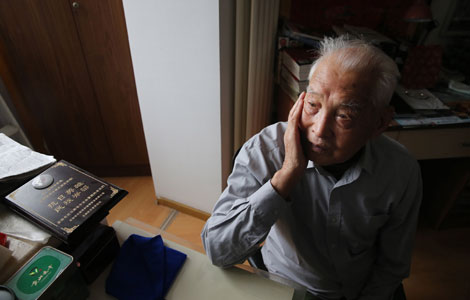Montreal, a port of call
Updated: 2013-09-29 07:28
By Raymond Zhou (China Daily)
|
|||||||||||
The Canadian city derives much of its quaint charm from its cultural offerings, which are abundantly provided in accessible venues and friendly environs, Raymond Zhou finds.
The best way to discover Montreal is to participate in some of its multitudinous and eclectic festivals.
Montreal stands out in North America for many things, among which is the dominance of the French language. This may have something to do with their attitude toward culture. In one word, they take their culture, and also presentations of other cultures, very seriously.
And nothing reflects the local love of culture better than the dozen festivals that enliven the city's mild summers and autumns.
|
The Olympic Stadium, with its inclined tower, testifies to the glory of the 1976 Montreal Olympics and is still a major tourist site. |
|
Sketch artists occupy the most prominent space in Old Montreal. |
The first time I visited Montreal was in the summer of 1986.
I took a group of Chinese acrobats to participate in what could have been a circus festival. I don't recall the name of the event or the venue at which we performed. But I remember we took some of the acts onto the street and attracted a zealous crowd.
After all, Montreal is home to the world-renowned Cirque du Soleil, which has always incorporated Chinese acrobats. But what would have been a routine technical showoff by the Chinese at home, when choreographed and arranged by Montreal-based talent, often takes on an artistic gloss.
For the past two years, I have been going to the second largest Canadian city for its film festivals that run from late August through early September.
This legacy was founded in 1977 by Serge Losique when the Venice Film Festival was in suspension.
Losique was instrumental in discovering China's Fifth Generation of directors when it was emerging from the mid-1980s State-owned production nebula. He showcased movies like Yellow Earth, raising their exposure to an international audience.
Most of the 400-plus films screened at the festival annually, hailing from across the world, serve more as windows for local film enthusiasts, who are extremely cosmopolitan and knowledgeable.
There are people who take vacations from work just to attend multiple screenings. The Cinema Imperial, one of the designated venues, often has a long line of moviegoers waiting outside its entrance before each film. And the question-and-answer session after a screening is often so lively it has to move to the corridor to make room for the next screening.
Audiences span the full age gamut, with the retired and the youth comprising the major components of participation.
Even if you don't have a budget for tickets, you can still go to the retrospective of prominent Quebecois films from the past year, which is free of charge.
Also free is the nightly open-air screening that reminds me of China's rural film showings of olden times. There is a flow of shared emotions, from the screen to the audience and among the audience members, which is palpable but beyond description.
This screening takes place at the center of the entertainment district, called Quartier des Spectacles in French. Within a 1-square-kilometer area are 30 performance halls and 130 cultural organizations.
There are seasons for the opera and the ballet, which are expected. On top of that, there are comedy festivals, called Just for Laughs, and all kinds of music and dance, ranging from jazz to heavy metal, from African rhythms to tango dance, from Caribbean carnival to dragon boat racing.
When you get tired of watching performing artists in Quartier des Spectacles, you can ramble down the street and end up in Quartier Latin (Latin Quarters) where street-side cafes offer great views for people-watching.
Many of the festivals take place here as well, including a multiplex for the film festival where you can literally engage in cinema hopping from one hall to another in search of your dream movie.

If you feel out of place in this chic bohemian enclave, you can elbow through the crowd in Le Vieux-Montreal (Old Montreal).
Here, cobblestone streets are dotted with street entertainers and sketch artists who would draw your likeness in a couple of minutes, or in the style of a celebrity.
The streets are lined with fine French dining establishments, with subdued traditional decor and quality food and wine one would normally associate with Paris. Well, Montreal is the largest French-speaking city outside of France with a total of 3 million people living in the metropolitan region.
Another thing I like about Montreal is a downtown that's within easy walking distance.
After tasting some great French cuisine at Old Montreal, you could saunter across a narrow street to the Old Port, where you can gaze up at the Clock Tower or relax on the sandy beach. Yes, there is an urban beach by the St. Lawrence River, where there is live entertainment in the early evening - classical music for Sunday and pop, jazz or electronica for the rest of the week - and sometimes fireworks at night.
One day, I walked all the way up into Mount Royal Park, through McGill University.
There were lots of people who rode bicycles up the hill. The footpath cuts through the trails up to the Kondiaronk Belvedere, a magnificent vista point that overlooks downtown Montreal.
A phalanx of spectators stood at the balcony, snapping pictures. The platform also housed a piano. Those who got tired watching the view could sit down and listen to the pianist.
Montreal is a great city for cyclists. It has a network of bicycle lanes, and you can rent a bike from one of 405 stations. Called BIXI, a blend of the words "bicycle" and "taxi", the service is a local innovation whose popularity has helped it spread to cities on three continents.
Special bike lanes lace Sainte-Helene and Notre-Dame Islands, two small islets in the middle of the river. Some bike lanes resemble an auto-racing circuit. So, you can ride as fast as you want.
Speaking of the islands, they were the sites of the 1967 World Fair. Many of the structures have been preserved - for instance, the US pavilion has been converted into Environment Canada's Biosphere, a premier venue for raising public awareness on air pollution, climate change and sustainable development. Plaques commemorate the locations where the original buildings no longer stand.
Montreal also hosted the 1976 Olympics, and the stadium is now a tourist attraction.
You can ride a cable car up to the observatory, which is the world's tallest inclined tower. I guess it was designed by an artist.
There are many things in Montreal you'll notice that are unique in subtle ways, as if local people do not have patience for conformity but want to imprint their city with a touch of personality.
That little something makes you linger while walking down the street or through a park.
And, of course, the rich variety of performances, including those on big screens, contributes greatly to the luster of a 371-year-old city.
Contact the writer at raymondzhou@chinadaily.com.cn.
|
A street-side eatery in the Latin Quarters is a place to see and be seen. |
|
A vista point on Mount Royal offers a panoramic view of the city. Photos by Raymond Zhou / China Daily |
(China Daily 09/29/2013 page16)
Today's Top News
UN's Syria resolution on point, FM says
China won't seek hegemony, FM tells UN
7.2-magnitude quake hits S, SW Pakistan
Obama, Iran's Rouhani hold historic phone call
UN votes to eliminate Syria's chemical weapons
'EU signal needed' for investment
China to pursue peaceful rise
FTZ to define development
Hot Topics
Lunar probe , China growth forecasts, Emission rules get tougher, China seen through 'colored lens', International board,
Editor's Picks

|

|

|

|

|

|









